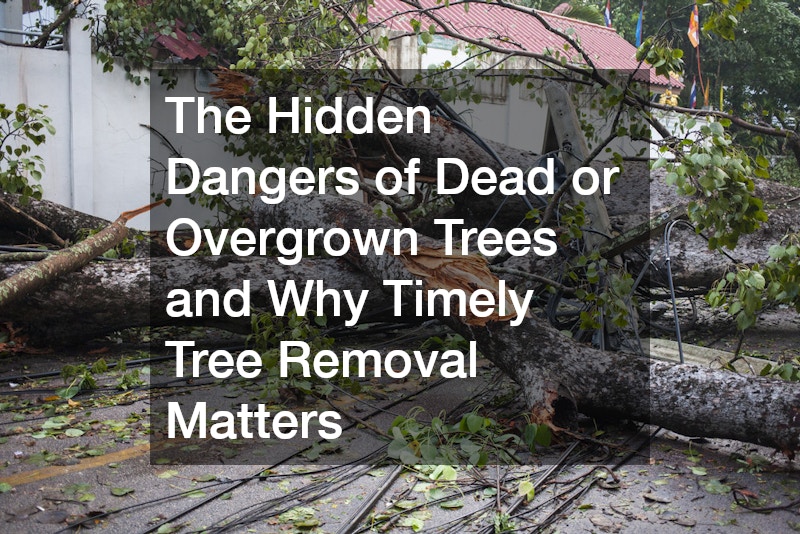Dead or overgrown trees can pose numerous risks to both property and personal safety, making it essential to understand why timely tree removal matters. This article delves into the hidden dangers associated with neglected trees and provides insights into why addressing this issue promptly is crucial. Maintaining a well-managed environment not only ensures safety but also preserves the aesthetic and functional qualities of a property.
Why Dead Trees Are Dangerous
Risks of Falling Branches or Trees
Dead trees or branches can fall without warning, creating a significant hazard to both people and property. The structural integrity of a dead tree weakens over time, making it increasingly likely to collapse during storms or high winds.
In urban areas, this risk is amplified as falling trees can cause extensive damage to homes, cars, and infrastructure.
Many communities report incidents where dead trees have fallen and caused harm or loss. The aftermath of such events can lead to expensive repair bills and potential lawsuits. It is vital for property owners to regularly inspect their trees and identify those that require immediate attention to prevent tragic accidents.
Pest Infestation and Spread
A dead tree can act as an invitation for pests such as termites, carpenter ants, and beetles. These pests are not just a problem for the dead tree; they can easily spread to nearby healthy trees, compromising their health and integrity. This can result in an infestation that affects the local ecosystem, leading to the rapid decline of plant diversity.
Dead trees also harbor fungal diseases, which can spread through spores to other trees, perpetuating a cycle of decline. As pests and diseases proliferate, property owners might find themselves facing escalating maintenance and treatment expenses. Timely removal of dead trees is a critical component in managing the spread of these threats.
Fire Hazards
Dead trees are incredibly susceptible to catching fire, especially during dry seasons or in areas prone to wildfires. The dry, brittle wood of dead trees serves as a perfect fuel if a fire were to occur. This can lead to rapid fire spread, endangering properties, wildlife, and human lives.
Communities located in wildfire-prone areas often prioritize the removal of dead trees to minimize fire risks. Even in less susceptible regions, a single dead tree near a home can become a significant vulnerability. Property owners are encouraged to assess not just the trees within their perimeter but also those in surrounding areas to mitigate these dangers.
How Overgrown Trees Affect Your Property
Damage to Structures and Utilities
Overgrown tree branches pose a threat to nearby structures, including homes, garages, and sheds. As branches extend and encroach upon buildings, they can scratch roofing materials, clog gutters, and even break windows during storms. The pressure exerted by these branches over time can lead to costly repairs and maintenance issues for property owners.
Utility lines are particularly vulnerable to damage from overgrown trees, resulting in power outages and other service disruptions. When tree limbs interfere with power lines, they can cause sparks that may lead to fires or other hazards. Utility companies often advise homeowners to maintain a safe distance between trees and power lines to ensure public safety.
Obstruction and Accessibility Issues
Overgrown trees can block driveways, sidewalks, and paths, causing inconvenience and safety concerns. These obstructions can limit access for vehicles, pedestrians, and emergency services, potentially leading to dangerous situations. Furthermore, branches hanging over streets or sidewalks can obscure visibility, increasing the risk of accidents.
Property aesthetics are also compromised by overgrown trees blocking scenic views, reducing the property’s appeal and market value. Not only do they impede natural light into homes, but they can also restrict airflow, impacting indoor comfort. Addressing these issues not only enhances functionality but also contributes positively to the overall appearance of the property.
The Benefits of Timely Tree Removal
Enhanced Safety and Prevention
Removing hazardous trees promptly enhances the safety of a property and reduces the risk of accidents. By addressing potential problems before they escalate, property owners can prevent issues such as falling branches or tree collapses. This proactive approach to tree management diminishes the likelihood of property damage and injuries.
An added safety benefit comes from eliminating the chance of pests residing in dead or weak trees. Pest infestations can necessitate costly treatments and disrupt the comfort of a home. By removing trees that pose a risk, homeowners can maintain a clean, safe living environment.
Improved Property Value and Appearance
Timely tree removal can significantly enhance the appearance of a property, boosting curb appeal and market value. A neat and tidy landscape creates a welcoming impression for visitors and potential buyers. By managing tree growth, property owners can showcase other aspects of their landscape design effectively.
Moreover, removing dead or dying trees can open up space for new, healthy growth, contributing to a vibrant garden environment. This can facilitate the planting of new shrubs, flowers, or trees that enhance the overall aesthetic appeal. A well-cared-for landscape indicates vigilant and responsible property maintenance to potential buyers.
Understanding the dangers of dead or overgrown trees can help property owners make informed decisions about timely tree removal. By addressing this issue proactively, individuals can ensure safety, preserve property value, and contribute to a healthier environment. Taking these steps not only benefits individual properties but also supports broader community and ecological well-being.
.

